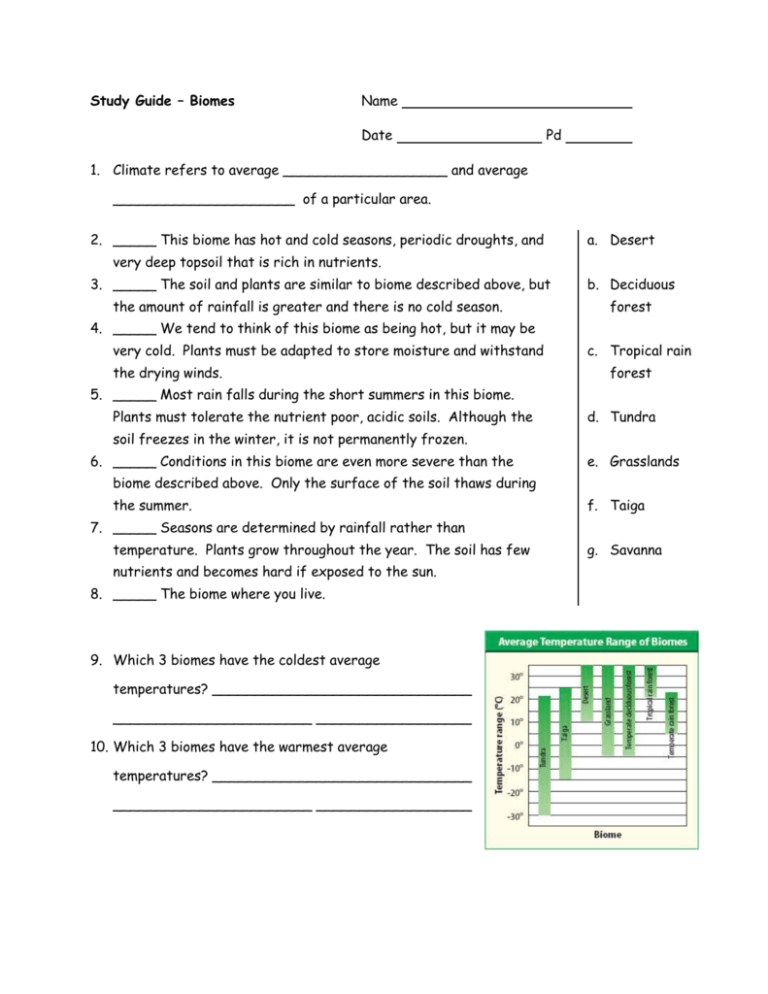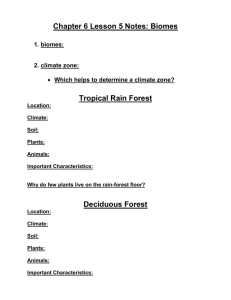Study Guide – Biomes Name Date Pd Climate refers to average and
advertisement

Study Guide – Biomes Name Date Pd 1. Climate refers to average ___________________ and average _____________________ of a particular area. 2. _____ This biome has hot and cold seasons, periodic droughts, and a. Desert very deep topsoil that is rich in nutrients. 3. _____ The soil and plants are similar to biome described above, but the amount of rainfall is greater and there is no cold season. b. Deciduous forest 4. _____ We tend to think of this biome as being hot, but it may be very cold. Plants must be adapted to store moisture and withstand the drying winds. c. Tropical rain forest 5. _____ Most rain falls during the short summers in this biome. Plants must tolerate the nutrient poor, acidic soils. Although the d. Tundra soil freezes in the winter, it is not permanently frozen. 6. _____ Conditions in this biome are even more severe than the e. Grasslands biome described above. Only the surface of the soil thaws during the summer. f. Taiga 7. _____ Seasons are determined by rainfall rather than temperature. Plants grow throughout the year. The soil has few nutrients and becomes hard if exposed to the sun. 8. _____ The biome where you live. 9. Which 3 biomes have the coldest average temperatures? ______________________________ _______________________ __________________ 10. Which 3 biomes have the warmest average temperatures? ______________________________ _______________________ __________________ g. Savanna Identify the animals found the given biomes: 11. _____ Polar Bears and musk ox a. Deciduous forest 12. _____ Lions and zebras b. Desert 13. _____ Sloths and Orangutan c. Grasslands 14. _____ Prairie dogs and bobcats d. Savanna 15. _____ Moose elk and black bears e. Taiga 16. _____ Armadillo lizard and coyote f. Tropical rain forest 17. _____ White-tail deer and eastern chipmunk g. Tundra Identify the animals found the given biomes: 18. _____ Spruce, fir, and pine trees a. Deciduous forest 19. _____ Elephant grass, eucalyptus trees, and whistling thorns b. Desert 20. _____ Mangrove forests, strangler vines, and bamboo c. Grasslands 21. _____ Birch, oak, and maple trees d. Savanna 22. _____ Caribou moss, pasque flower, and diamond-leaf willow e. Taiga 23. _____ Barrel cactus, Joshua tree, and yucca f. Tropical rain forest 24. _____ Buffalo grass, sunflower, and clover g. Tundra Match the wetland definitions with the correct term: 25. _____ Soil that can hold as much as 100 times its weight in water a. Hydric 26. _____ Soil flooded long enough it will develop anaerobic conditions b. Hydrophyte 27. _____ Plants adapted to life in wet environments c. Peat 28. _____ Soil that has partially decayed plant material d. Muck 29. _____ Organic soil material in which the original plant parts are not recognizable 30. List the zones of ocean waters: 31. List 4 signs of a wetland:











